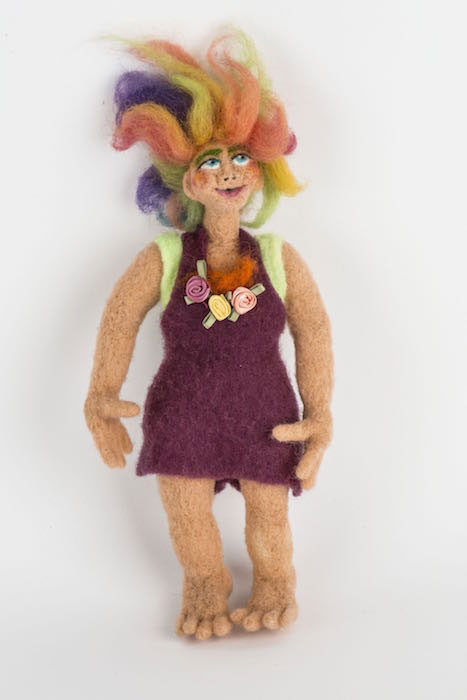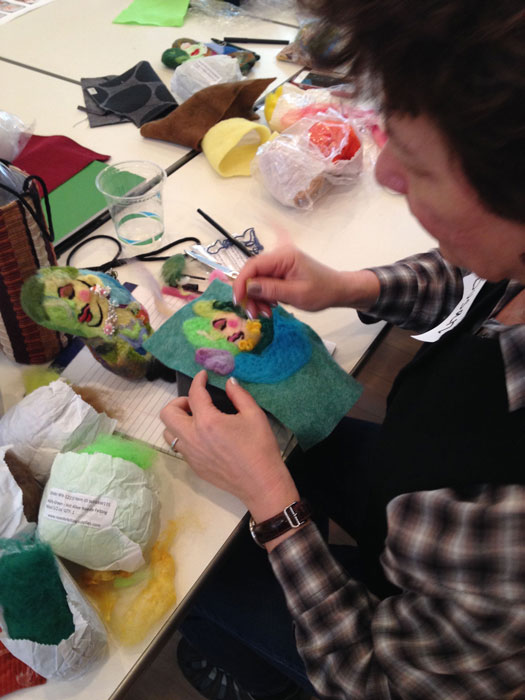
Erika Cleveland is an artist who lives in Washington, DC. She creates her healing dolls using needle felting and exhibits at the Torpedo Factory in Alexandria, VA. Her dolls have won awards in the Torpedo Factory’s Target Gallery and at other venues in the Washington, D.C. area. She also offers healing doll workshops at the Smith Center for Healing and the Arts in D.C. Cleveland earned a master’s from NYU and worked as an art therapist for 13 years. She also attended the School for the Museum of Fine Arts in Boston.
“Celebrating Change for Women in Transition”
I learned about Erika Cleveland when she responded to our call for artists for the Manhattan Arts International 2015 juried competition. Her website greets you with “Celebrating Change for Women in Transition.” She offers instructions individually and in group workshops and also creates commissioned pieces. She has also presented workshops to teach fellow art therapists the healing techniques derived from doll-making.
RP: Erika, what exactly is needle felting?
EC: Needle felting is using a barbed needle to attach fibers together, usually wool, but other fibers can be used. The needle is repeatedly jabbed into the fibers until they hold together without the use of any other support structure or armature, to create three-dimensional figures. This is in contrast to “traditional” felting, which uses water, heat and friction to enable the fibers to adhere to one another. Needle felting is most commonly used as an embellishment technique to surfaces that have already been felted in the traditional manner.
RP: You excel in many different mediums. What led you to doll-making?
EC: I’m at that stage of life, recently hit 50, where priorities shift and what once seemed important has changed. I am living the phrase, “teach what you most need to learn,” making dolls that are meant to be a catalyst for change.
Previously I painted in acrylic, exploring personal imagery. Then I shifted to printmaking. While attending the School of the Museum of Fine Arts in Boston, I created organic, non-representational sculptural hand-made paper forms. I sought to capture inner experiences during the process of change. Now I seek to capture the inner experience of change through doll-making, giving the process a personal face.
RP: Can you explain why there are healing benefits inherent in doll-making?
EC: I remember reading, as an art therapy graduate student that dolls “reflect numinous facets of their possessors’ unknown identity. They embody threshold guardians in developmental transitions. They are potent objects of comfort and companionship” and they help to express emotions. (D.W. Winnicott).
It means that dolls reflect us back to ourselves. There is magic in creating a doll in that you start out with; an area of the body that needs healing, a difficult relationship or an upcoming change, but you never know what the doll is actually going to become.
RP: Is there a doll you created that you identify with the most?
EC: I might ask myself, what does your best, bravest self look like? And “Rhea: Shedding the Old” is what emerged in response to that question. She’s vulnerable, yet strong. She is releasing the “skin” of the old fears. This doll is my touchstone. I am comforted in her presence.

RP: What do you teach in your workshops?
EC: I focus on the unique techniques of wet felting and sculptural needle felting. Both are highly adaptable techniques which can be used with a wide range of clients. Wet felting has existed since approximately the beginning of recorded time, whereas sculptural needle felting began as an artistic technique in the 1980’s. Requiring simple tools and set-up, both techniques are fairly easy to learn and to teach.
RP: On your website you share many positive testimonials from participants in your workshops. Please describe the kind of “transformation” that occurs.
EC: In a recent workshop called “Mapping Your Internal Landscape,” participants rested on mats and visualized sending messages of gratitude and healing to various parts of their bodies. Then they created a felted body landscape, using their visualized images. They wrote about the experience and then shared their words and creations with each other, acting as “believing mirrors” for each other.
Vulnerable, yet strong, an overarching theme of courage emerged. Figures flowed with the waves, merged with the trees, and embraced parts of themselves that needed special healing energy. Elements from nature, such as trees, roots and leaves, dragonflies and shells made their way into the work.
One participant, whose image, for me speaks to the whole theme of the workshop, created a body with a mouth in her belly, allowing the body to tell it’s own message, to speak its own truth.
RP: Erika, I know you also create commissioned dolls. What could someone expect from this experience?
EC: We sit together — virtually or in real space — and discuss your personal stories and symbols. I will let my intuition, combined with your insights, guide me to create a doll that holds your chosen qualities such as courage and wisdom within. Sometimes I create a mini journal with guidance I receive during the doll-making process. A final meeting allows you the time to absorb and discuss the full experience of what your doll has to say to you. The best way for you to receive healing is to create a doll yourself.
Visit Erika Cleveland’s website: transformativehealingdolls.com

Dear Erika Cleveland,
I would be delighted to be able to take your full group class starting in April on Wednesdays
from 2-3:30pm. My friend Linda McNutt would like to be in the same class if that is possible.
She will be writing to you also.
Your work is wonderful and I’m so glad to have heard about you and your excellent work.
Thank you